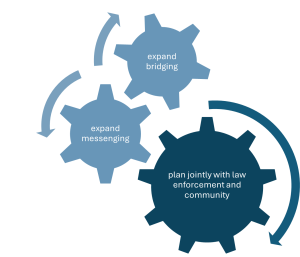9. Plan with Law Enforcement and Community Leaders to Address Hate Incidents
Threats, harassment, and violence that target persons based on membership in a particular group hurt the entire community. Hate incidents[1] may deeply impact the direct victims, evoke fear among others who identify with the targeted group, and stimulate anger throughout the community.[2] Community leaders and law enforcement can usefully plan together to support those who are in danger or anxious and help prevent future hate incidents. By planning ahead, leaders can help ensure that every resident feels seen, supported, and safe—especially in moments of crisis.
Why take this step?
 Hate incidents—threats, harassment, or violence targeting individuals based on group identity—harm not only the victims but the entire community. These events can instill fear, provoke anger, and deepen divisions. People expect their leaders to act immediately when a hate incident occurs. Leaders can do that more effectively with advanced planning by both law enforcement and other community leaders.
Hate incidents—threats, harassment, or violence targeting individuals based on group identity—harm not only the victims but the entire community. These events can instill fear, provoke anger, and deepen divisions. People expect their leaders to act immediately when a hate incident occurs. Leaders can do that more effectively with advanced planning by both law enforcement and other community leaders.
Transparent communication helps. While some leaders may hesitate to speak publicly about a hate incident, fearing it will upset uninformed residents, silence often sends the wrong message. Targeted groups are usually aware of incidents through social media and may interpret silence as indifference or concealment. Experienced leaders advise erring on the side of speaking out.
Educating the broader community matters. Hate incidents often disproportionately affect one group. Without context, others may dismiss the impact or suggest the victims are overreacting—responses that can deepen alienation and resentment.
Preparation builds trust. It enables leaders to act quickly, reduce anxiety, and foster solidarity among residents, especially those who share the targeted identity. It also provides allies in the community an opportunity to speak up and offer or provide support.
How to take this step
CHECKLIST: Agenda items for planning to address hate incidents
How will each of these matters be conducted and who has responsibility for them?
- Address safety and anxiety immediately and frequently, with special attention to members of the group that was targeted.
- Humanize members of a targeted group, helping other residents care about them and understand their suffering and fear.
- Reinforce community values and aspirations, including those violated in the hate incident and those that motivate the community to come together to help those affected.
- Touch base with influential community influencers who are willing to speak out against threats, harassment, and violence, even if they agree politically or philosophically with the potential perpetrators.
- Provide multiple ways to report hate incidents, keeping in mind whom various persons will trust and who will respond with resources for the residents affected, even if no crime will be charged.
- Offer residents ways to help, including options for them to: support fellow residents, create communication chains about safety, help plan vigils, and encourage and facilitate conversations across differences.
- Anticipate and plan together for future hate incidents:
- Counter exaggerated or untrue attributions of blame, and targeted misinformation or disinformation, as these may fuel a hate incident.
- Analyze hate incidents occurring elsewhere, offer support to residents for whom hate incidents elsewhere might elevate anxiety, and prepare ahead for similar occurrences in your community.
- Pre-Bunk: Anticipate that some will level blame against particular groups when something bad happens – without evidence that the targeted group deserves blame — and warn residents ahead of that occurring and the potential motives for those circulating false narratives in social media posts.
- Decide who should receive training to identify hate incidents, increase reporting, prosecute, discipline or speak against perpetrators, and support reporters and others affected, even if no prosecution will occur.
The checklist in Chapter 7 may help leaders prepare to reach out in the moment, speaking earnestly and empathically, responding with urgency to safety concerns, and promoting understanding among those not targeted. It can be adapted to your circumstances and handed out to all those who may communicate after the incident, including influential clergy, trusted community and business leaders, social media influencers, and others.
By establishing a group of people who will watch for incidents elsewhere or tensions locally, law enforcement may be able to protect likely targets, posting police, for example, at places of worship, ethnic gathering places, and on the roofs of building surrounding large public events.
Beyond protection, preparation can focus on reducing the likelihood that individuals will hate members of a particular group. Researchers have identified leadership actions that tend to reduce violence or partisan animosity or that increase support for the rule of law. Actions that seem to help include:
- humanizing members of the targeted group,
- reinforcing community values, seeking other influential bipartisan members to speak out together against acting on hate,
- countering – with specificity — lies that target a group with blame, and
- pre-bunking or inoculating against an anticipated attempt to blame a group.[3]
ILLUSTRATION | Contracting responses in two Midwestern Communities
Reacting to a hate incident.
On the eve of a summer holiday, a white supremacy group distributed recruiting flyers throughout a park frequented by children playing various sports and picnicking families. One flyer said, “white youths in revolt” and another “it’s our duty to guard against the foreign horde.” The flyers included a membership website for “youth clubs.” One included a logo that included “honor, blood, youth, united.
News of the flyers and their content spread informally by word of mouth and on social media throughout the holiday weekend, especially among members of the targeted groups. The city released only an unsigned statement of awareness that flyers had been left in city parks, that the distribution of flyers was unauthorized (ordinance cited), and that they would be removed. The statement termed the distribution a misuse of public property and reaffirmed the city’s commitment to offering public spaces that were “safe and welcoming to everyone.” The language and manner of release communicated “business as usual” and did not help residents understand the groups who had been frightened and angered; they did not know how to offer support or the need to do that.
In contrast, Mayor Nan Whaley of Dayton, Ohio, used “not business as usual“ language to call out the hate (being careful not to give t

he hate group unnecessary publicity), explain its impact on fellow residents, condemn it, explain city concern for safety, reference community values, and encourage support and reporting:
“The presence of this hate group in Dayton is extremely frustrating. We do not want this group here. We are angry that we have to spend public resources responding to people who want to make our neighbors feel less safe. In so many ways, this event detracts from all of the work we should be doing in our community. This group’s only goal is to provoke a response and to create anger and division. It is troubling that media attention has amplified the hateful views of a handful of degenerates to a national audience. That being said, I am proud of Daytonians’ overwhelming response of standing together and insisting that all of our neighbors be treated with dignity and respect. We’re hopeful that the rally tomorrow happens without incident, and Dayton Police and Fire have worked closely with public safety experts across the country to create a space for everyone to safely express their views. The City of Dayton does not want these people here. I hope this weekend will be remembered only for the way that Daytonians stood united against hate.” [4]
Pre-bunking false statements of blame to reduce the chances of violence: A fictional illustration of inoculating residents against false blaming:
In the context of a furnace explosion causing injuries or something similar, the mayor might extend concerns for those hurt, explain what is being done to help them, detail what is known about and being done to investigate the cause, and then add something like this pre-bunking message:
“Because it may take several weeks for experts and law enforcement to determine the cause of the explosion, some people may be tempted to take political or other selfish advantage of the situation in the meantime – baselessly blaming for what occurred whatever group fits their political or selfish viewpoint. A message this surprising may be elevated on social media. So, when you hear someone say that this explosion was caused by a particular group, please treat that attribution skeptically. Be assured that we will be providing an evidence-based explanation of the cause as soon as we have it.”
- For simplicity of discussion, we lump these acts together in the term “hate incident,” which includes non-criminal acts as well as crimes. ↵
- Princeton University Bridging Divides Initiative, Key Political Violence and Resilience Trends from 2024 (2025), https://bridgingdivides.princeton.edu. ↵
- Jon Roozenbeek et al., Prebunking Interventions Based on “Inoculation” Theory Can Reduce Susceptibility to Misinformation Across Cultures, Harvard Kennedy School Mis/Information Rev. (Feb. 3., 2020), https://misinforeview.hks.harvard.edu/article/global-vaccination-badnews/; Megan K. McBride et al., Evidence-Based Techniques For Countering Mis-/Dis-/Mal-Information (2024), https://www.vaemergency.gov/aem/blue-book/reading-corner/evidence-based-techniques-for-countering-mis-dis-mal-information.pdf. ↵
- https://www.daytonohio.gov/ArchiveCenter/ViewFile/Item/1318 (May 24, 2019). ↵
